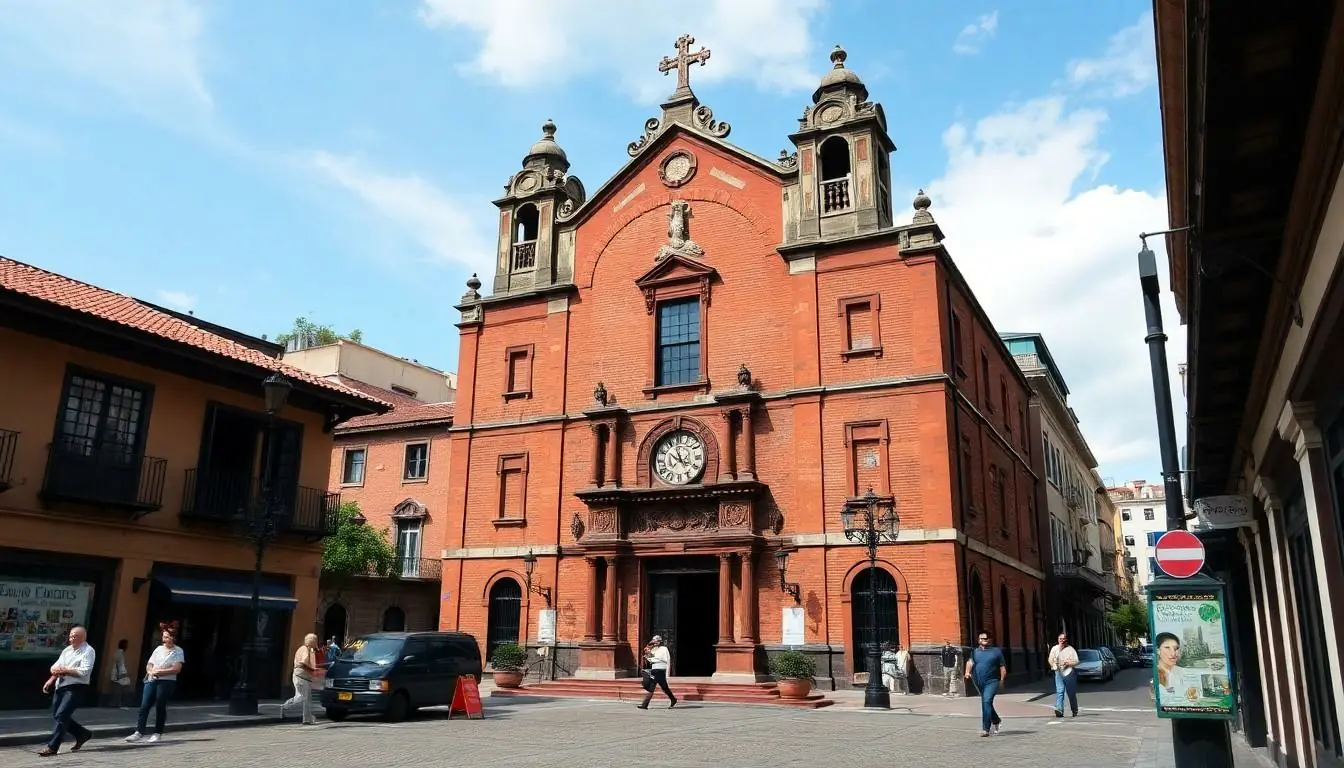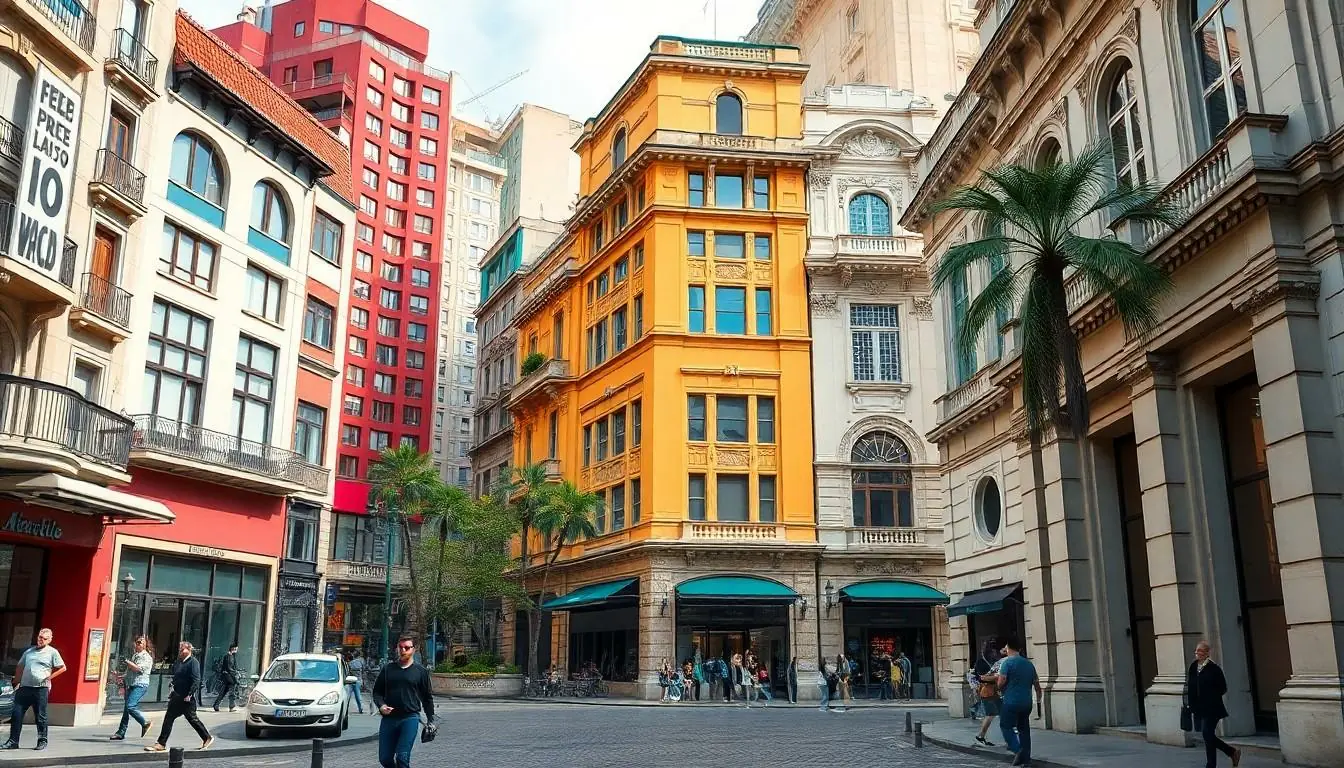Buenos Aires isn’t just the tango capital of the world; it’s also a playground for architecture lovers. From stunning Art Deco buildings to grand neoclassical structures, the city’s skyline tells a story that’s both rich and diverse. Imagine strolling through streets where every corner reveals a new architectural gem, each with its own quirky personality.
Table of Contents
ToggleOverview of Buenos Aires Architecture
Buenos Aires boasts a rich architectural heritage that reflects its diverse cultural influences. The city’s skyline merges different styles, including Italian Renaissance, Art Deco, and modernist designs. Exploration reveals iconic landmarks, such as the Casa Rosada, showcasing neoclassical elements that highlight the city’s history.
Walking through the neighborhoods uncovers hidden gems like San Telmo and La Boca, where colorful buildings stand out against cobblestone streets. Each district tells a story through its structures, from the ornate facades of Palermo’s mansions to the minimalist lines of contemporary architecture in Puerto Madero.
Architects such as Clorindo Testa and Mario Roberto Álvarez significantly shaped Buenos Aires’ urban landscape. Their renowned works demonstrate a commitment to innovative design paired with traditional themes. Various public spaces, like the iconic Obelisco, serve as central points for civic pride, hosting numerous events throughout the year.
In addition to historic buildings, Buenos Aires embraces sustainable architecture and green spaces, emphasizing ecological design principles. Parks like the Bosques de Palermo not only provide recreational areas but also feature landscape architecture that harmonizes with the surrounding city.
Overall, Buenos Aires’ architecture reveals a narrative of transformation and resilience. The blend of old and new highlights the city’s ongoing evolution, making it an exciting location for architecture enthusiasts and casual visitors alike.
Historical Influences

Buenos Aires showcases a blend of various historical influences through its diverse architectural styles. The city’s rich past and immigration history significantly shaped its urban landscape.
Colonial Architecture
Colonial architecture in Buenos Aires features a unique mix of Spanish and indigenous influences. Notable structures such as the Cabildo illustrate the use of brick and stucco in early colonial designs. These buildings often highlight symmetrical layouts and simple ornamentation. In neighborhoods like San Telmo, many colonial homes still exhibit traditional tile work, showcasing craftsmanship from the era. Colonial influences fostered a sense of identity and continuity in the city’s development.
European Influence
European influence permeates the architecture of Buenos Aires, especially in the 19th and early 20th centuries. Architects brought styles from France, Italy, and Spain, transforming the skyline into a European-inspired marvel. Iconic landmarks, such as the Teatro Colón and Casa Rosada, reflect these eclectic styles featuring ornate details and grand façades. Many neighborhoods, including Recoleta, exhibit elegant buildings reminiscent of Parisian designs, adorned with intricate balconies and decorative elements. This fusion creates an architectural narrative that embodies the city’s cosmopolitan essence.
Key Architectural Styles
Buenos Aires showcases a rich tapestry of architectural styles, making it a noteworthy destination for enthusiasts.
Neoclassical
Neoclassical architecture in Buenos Aires reflects grandeur and elegance, characterized by its symmetry and monumental scale. The Casa Rosada stands as an iconic example, with its pink façade and classical columns. Structures like the Palacio de Aguas Corrientes showcase intricate detailing and impressive domes. This style draws inspiration from ancient Greek and Roman architecture, emphasizing harmony and proportion. Neighborhoods featuring neoclassical elements often blend historical significance with modern use, allowing residents and visitors to appreciate the past while engaging with the present.
Art Deco
Art Deco makes a bold statement in Buenos Aires through vibrant colors and geometric patterns. Structures such as the Palacio Barolo exemplify this decorative style with their ornate sculptures and bright designs. Art Deco buildings often incorporate luxurious materials, showcasing craftsmanship in every detail. The influence of this movement during the 1920s and 1930s brought a sense of modernity to the city. Walk through districts adorned with Art Deco masterpieces, and discover how this distinctive style adds to the city’s cultural diversity.
Modernism
Modernism in Buenos Aires introduces a fresh take on urban architecture with minimalistic forms and functional designs. Key figures like Clorindo Testa brought innovative concepts that revolutionized the architectural landscape. Structures such as the Hospital Posadas and the Museo de Arte Moderno illustrate the essence of modernist principles with their clean lines and open spaces. This style prioritizes functionality and environmental integration, responding to the evolving needs of urban living. Exploring modernist architecture reveals how Buenos Aires embraces change while preserving its architectural heritage.
Notable Landmarks
Buenos Aires showcases remarkable landmarks that capture its architectural diversity and cultural significance.
The Casa Rosada
Casa Rosada serves as the presidential office and exhibits neoclassical design elements. This iconic pink building features a unique façade that symbolizes political history and power. The terrace provides stunning views of the Plaza de Mayo, where many historical events occurred. Intricate details adorn the balconies and windows, showcasing craftsmanship from the past. Guided tours allow visitors to explore grand hallways and the famous balcony where leaders addressed the public. Generations of Argentinians recognize Casa Rosada as a central point for national pride and identity.
Teatro Colón
Recognized as one of the finest opera houses globally, Teatro Colón features exceptional acoustics and stunning architecture. The Italian Renaissance style creates an atmosphere of grandeur and elegance. Inside, visitors discover lavish decorations, including gold leaf and exquisite chandeliers. This venue has hosted renowned performers and orchestras, solidifying its reputation in the arts. Cultural events attract audiences from around the world, enhancing Buenos Aires’ cultural landscape. The guided tours delve into the history and architectural details, allowing guests to appreciate its significance.
El Obelisco
Standing tall at 67 meters, El Obelisco serves as a key symbol of Buenos Aires. Located at the intersection of two major avenues, its strategic placement makes it a popular gathering spot. Completed in 1936, this monument commemorates the city’s fourth centenary. Surrounding public spaces often host celebrations or protests, linking the monument with civic events. Tourists frequently visit for photo opportunities and unique perspectives of the cityscape. Its illuminated presence at night highlights the drama of Buenos Aires’ urban environment.
Contemporary Architecture
Contemporary architecture in Buenos Aires showcases innovative designs and sustainable practices that redefine urban living. This ever-evolving architectural scene contributes to the city’s dynamic skyline.
Innovative Designs
Architects in Buenos Aires embrace contemporary design principles, pushing boundaries with innovative structures. Notable examples include the Faena Arts Center, which blends industrial history with modern artistry. The Cactus House in Villa Devoto stands out for its unique geometric forms and vibrant facades. These buildings demonstrate creativity while enhancing functionality within urban settings. In Puerto Madero, the towering Zeta Building epitomizes modernism, featuring sleek lines and expansive glass elements. New developments continue to emerge, reflecting global trends while honoring the city’s character.
Sustainable Practices
Sustainability plays a critical role in Buenos Aires’ architectural evolution. Architects prioritize eco-friendly materials and energy-efficient designs. The El Tren del Parque project reflects this commitment by transforming disused railway lines into green urban spaces. Similarly, the Eco-park in Palermo integrates nature with recreational spaces, promoting environmental awareness. Residential buildings increasingly incorporate green roofs and solar panels, reducing energy consumption. Strategies such as rainwater harvesting enhance resource management across the city. Overall, these sustainable practices demonstrate Buenos Aires’ dedication to a greener urban future.
Buenos Aires stands as a testament to architectural diversity and cultural richness. Its unique blend of styles tells stories of the past while embracing the future. Each neighborhood offers a distinct experience where history and modernity coexist seamlessly.
From the grandeur of neoclassical landmarks to the boldness of Art Deco and the innovation of contemporary design, the city captivates all who explore its streets. Buenos Aires not only celebrates its architectural heritage but also commits to sustainable practices that enhance urban living.
For anyone passionate about architecture or simply seeking inspiration, Buenos Aires is a destination that promises to leave a lasting impression.



